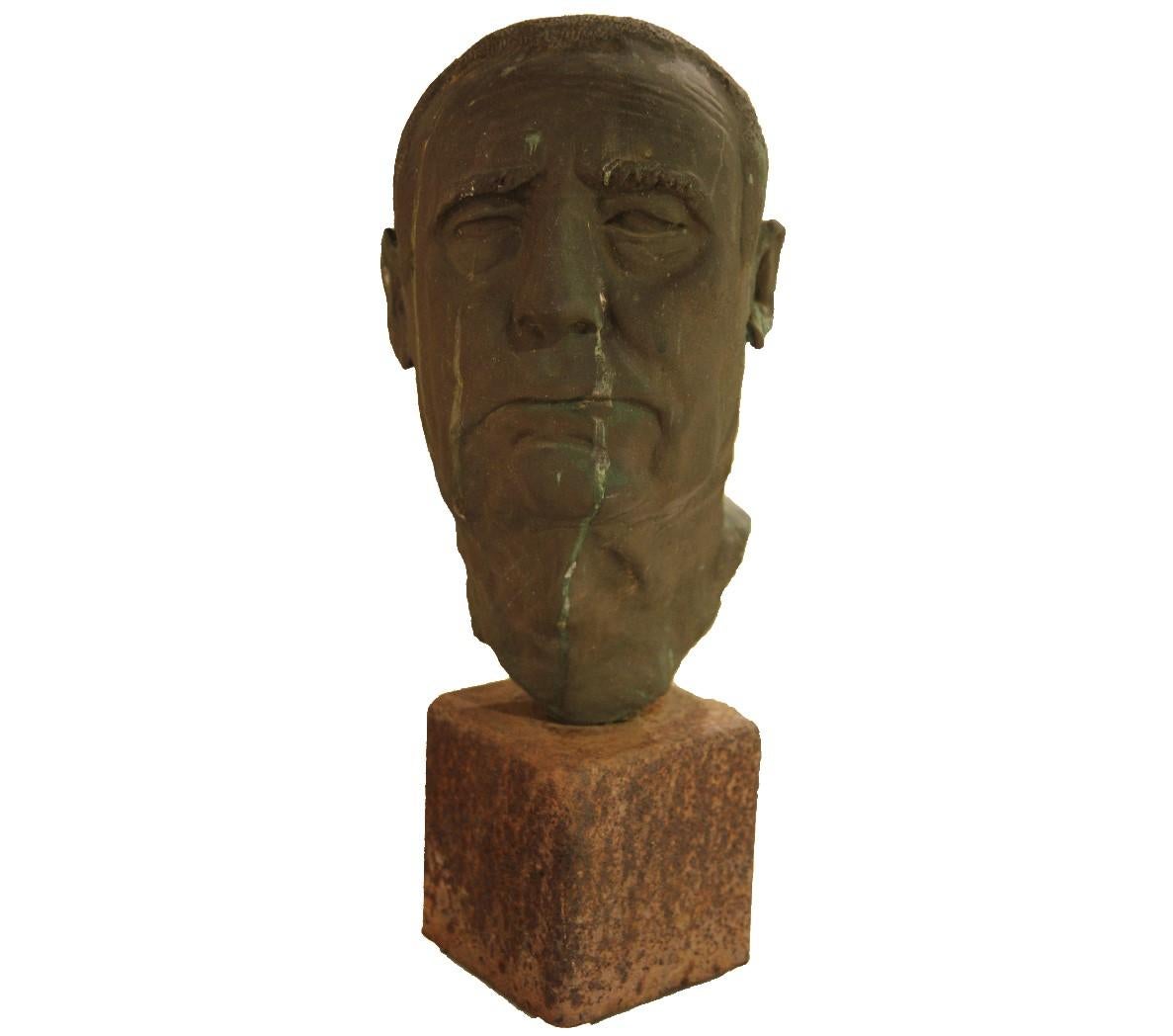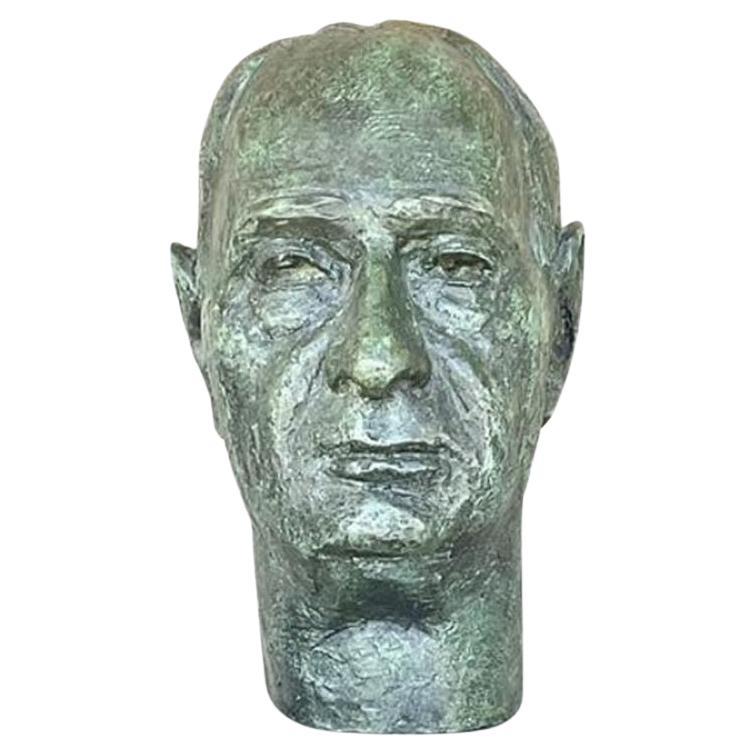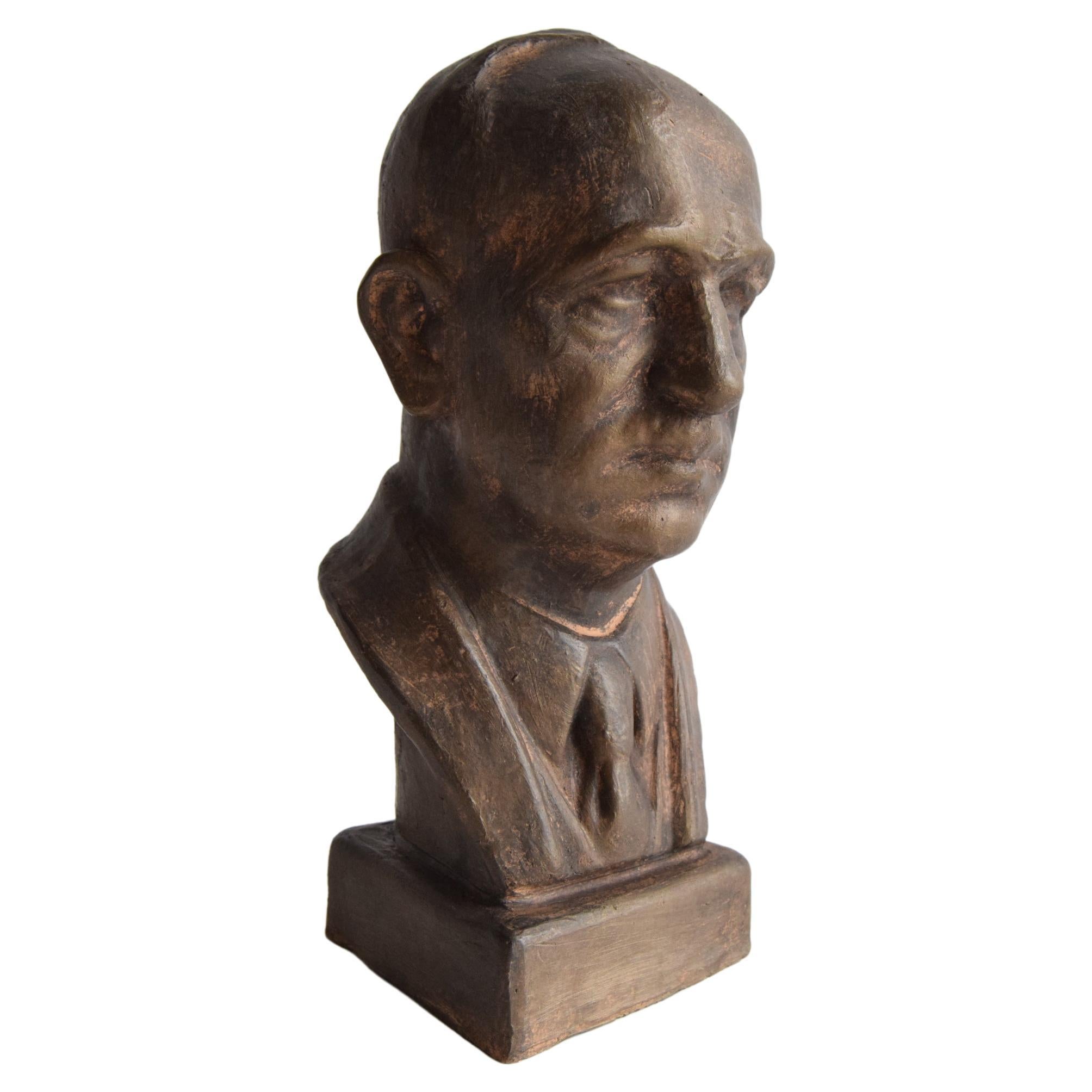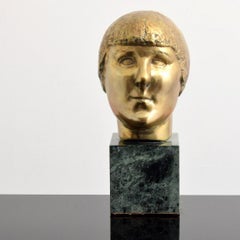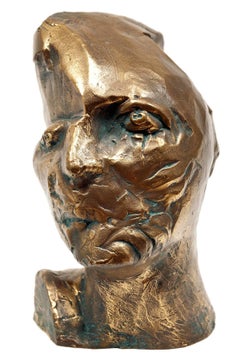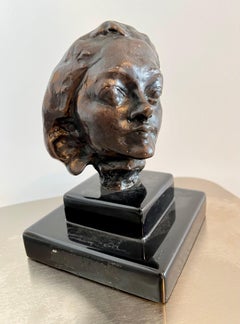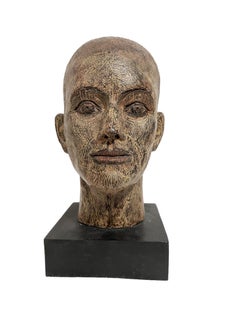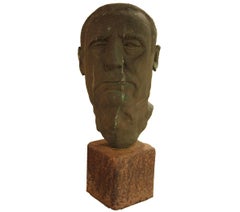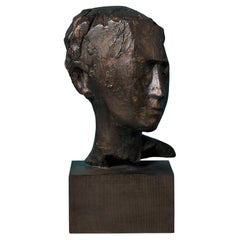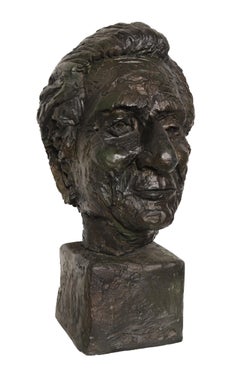Items Similar to Bronze Modernist Sculpture Portrait, Leo Stein by Minna Harkavy WPA Artist
Want more images or videos?
Request additional images or videos from the seller
1 of 10
Minna HarkavyBronze Modernist Sculpture Portrait, Leo Stein by Minna Harkavy WPA Artistc.1930-1940
c.1930-1940
$3,500
£2,654.05
€3,070.85
CA$4,947.38
A$5,515.38
CHF 2,876.50
MX$66,693.67
NOK 36,158.95
SEK 34,213.59
DKK 22,920.79
About the Item
Minna Rothenberg Harkavy (1895-1987) Estonian-American
This is not signed
bronze portrait bust
Provenance: Estate of the artist by descent
Minna Harkavy (1887 – 1987) (birth occasionally listed as 1895) was a Jewish American sculptor born in Estonia to Yoel and Hannah Rothenberg and immigrated to the United States around 1900.
She studied at the Art Students League, at Hunter College and in Paris with Antoine Bourdelle.
Harkavy was a WPA Federal Art Project artist, for whom she created a 1942 wood relief piece, Industry and Landscape of Winchendon for the post office in Winchendon, Massachusetts.
She was a founding member of the Sculptors Guild and showed a work, My Children are Desolate Because the Enemy Prevailed in the Second Outdoor Sculpture Exhibition Negro Head in the 1940-1941 and Woman in Thought in 1941.
Harkavy was an early feminist, a founding member of the New York Society of Women Artists. Politically she was known as a leftist and anti-fascist with a strong social consciousness. In 1931 she exhibited a bust of Hall Johnson in the Museum of Western Art in Moscow and the work was purchased for the Pushkin Museum there. Abraham, Walkowitz sat for a portrait by her. In 1932 she represented the John Reed Club at an anti-war conference in Amsterdam.
A bust of Italian- American anti-fascist (and her lover) Carlo Tresca who was assassinated in New York in 1943 was installed in his birthplace of Sulmona, Italy. She showed at Associated American Artists gallery, along with Max
Weber, Waldo Peirce, Ernest Fiene, George Biddle, Isabel Bishop, Arnold Blanch, Adolph Dehn, Thomas Hart Benton, John Sloan, Raphael Soyer and William Zorach. She was one of 250 sculptors who exhibited in the 3rd Sculpture International held at the Philadelphia Museum of Art in the summer of 1949. Her bronze sculpture American Miner’s Family is owned by the Museum of Modern Art and the large stone sculpture Two Men won first prize in a sculpture competition at the Metropolitan Museum of Art in 1951. Harkavy helped to found the New York Society of Women Artists in 1920 and the American Artists’ Congress and Sculptors’ Guild in the 1930s. She was a frequent orator and spoke on behalf of the John Reed Club at a Communist anti-war conference in Amsterdam in 1932. Harkavy also served on the art committee of the American section of the Jewish cultural organization, the Yidisher Kultur Farband (YKUF). Her work was featured in group exhibitions at the Jewish Art Center, John Reed Club, and both the Whitney Studio Club and Whitney Museum. A retrospective of Harkavy’s work was mounted in 1956 at the Rhode Island School of Design, Providence. She also sculpted in marble
She married Louis Harkavy, a New York pharmacist who also wrote for Yiddish-language periodicals.
SELECT COLLECTIONS
USPO, Winchendon, Massachusetts
Metropolitan Museum of Art
Whitney Museum of American Art
Kalamazoo Institute of Arts, Kalamazoo, Michigan
Butler Institute of American Art, Youngstown, Ohio
Wichita State University, Edwin A. Ulrich Museum of Art, Wichita, Kansas
Merchandise Mart, Chicago, Illinois
Hermitage Museum in Leningrad, Russia
Pushkin Museum in Moscow
Mishkan LeOmanut museum, Ein Harod, Israel
Harkavy's New England Woman, was displayed at the New York World's Fair of 1939
Leo Stein (1872 – 1947) was an American art collector and critic. He was born in Allegheny City (now in Pittsburgh), the older brother of Gertrude Stein. He became an influential promoter of 20th-century paintings. Beginning in 1892, he studied at Harvard University in Cambridge, Massachusetts, for two years. The following year, he traveled the world with his cousin, Fred. In 1897, he transferred to Johns Hopkins University in Baltimore, Maryland, where he graduated with a Bachelor of Arts degree in 1898. Stein spent a number of years living in Paris with his sister.
By early 1906, Leo and Gertrude Stein's studio had many paintings by Henri Manguin, Pierre Bonnard, Pablo Picasso, Paul Cézanne, Pierre-Auguste Renoir, Honoré Daumier, Henri Matisse, and Henri de Toulouse-Lautrec. She hosted a Paris salon, where the leading figures of modernism in literature and art, such as Pablo Picasso, Ernest Hemingway, F. Scott Fitzgerald, Sinclair Lewis, Ezra Pound, Sherwood Anderson and Henri Matisse, would meet. She sat for a sculpture portrait by Jacques Lipchitz. In 1933, Stein published a quasi-memoir of her Paris years, The Autobiography of Alice B. Toklas. In 1914, the two separated due to Leo's resentment of Gertrude's infatuation with Alice B. Toklas, whom he described as "a kind of abnormal vampire". Stein returned to America to work as a journalist but eventually settled near Florence, Italy, with his long-time love interest, Nina Auzias. They eventually married in 1921.
- Creator:Minna Harkavy (1887 - 1987, Estonian)
- Creation Year:c.1930-1940
- Dimensions:Height: 16 in (40.64 cm)Width: 7.25 in (18.42 cm)Depth: 10 in (25.4 cm)
- Medium:
- Movement & Style:
- Period:
- Condition:good. still has residue from thee original laster from the casting.
- Gallery Location:Surfside, FL
- Reference Number:1stDibs: LU38215796522
About the Seller
4.9
Platinum Seller
Premium sellers with a 4.7+ rating and 24-hour response times
Established in 1995
1stDibs seller since 2014
1,798 sales on 1stDibs
Typical response time: <1 hour
- ShippingRetrieving quote...Shipping from: Surfside, FL
- Return Policy
Authenticity Guarantee
In the unlikely event there’s an issue with an item’s authenticity, contact us within 1 year for a full refund. DetailsMoney-Back Guarantee
If your item is not as described, is damaged in transit, or does not arrive, contact us within 7 days for a full refund. Details24-Hour Cancellation
You have a 24-hour grace period in which to reconsider your purchase, with no questions asked.Vetted Professional Sellers
Our world-class sellers must adhere to strict standards for service and quality, maintaining the integrity of our listings.Price-Match Guarantee
If you find that a seller listed the same item for a lower price elsewhere, we’ll match it.Trusted Global Delivery
Our best-in-class carrier network provides specialized shipping options worldwide, including custom delivery.More From This Seller
View AllBronze Modernist Sculpture Portrait, Gertrude Stein by Minna Harkavy WPA Artist
Located in Surfside, FL
Minna Rothenberg Harkavy (1895-1987) Estonian-American
signed
bronze portrait bust, marble, stone base.
Minna Harkavy (1887 – 1987) (birth occasionally listed as 1895) was a Jewish ...
Category
Early 20th Century American Modern Figurative Sculptures
Materials
Bronze
Untitled, Head Of An Artist, Avant-Garde Bronze Sculpture
By Phillip Pavia
Located in Surfside, FL
This is a bronze cast sculpture by Philip Pavia is part of his series of "Imaginary Portraits from the Club" , a one-man exhibition at Max Protetch Gallery, New York in 1982. The approach at rendering the figure is grotesque, and the facial features have been severely distorted to the point were the portrait becomes an abstract interpretation of the subject.
As an artist and writer, Philip Pavia was a committed member of the Abstract Art community throughout his long, distinguished career. Pavia was active in the art world until his death in 2005 and received immense critical praise for his artistic and literary contributions. Recognized for his signature work The Ides of March...
Category
20th Century Abstract Expressionist Figurative Sculptures
Materials
Bronze
Small Bronze Sculpture Cast Head After Rodin "Petite tete au nez retrousse"
By Auguste Rodin
Located in Surfside, FL
(after) Auguste Rodin
Posthumous cast
"Petite tete au nez retroussé"
Featuring a bust of a woman.
Limited edition bronze is mounted on a marble base and is signed on the lower right. Great detail.
Dimensions: approx. 7-1/4" tall x 5" across x 5" deep with base
Foundry mark on the reverse, #13 of 299 produced.
François Auguste René Rodin (1840 – 1917) was a French sculptor generally considered the founder of modern sculpture. Rodin possessed a unique ability to model a complex, turbulent, and deeply pocketed surface in clay. He is known for such sculptures as The Thinker, Monument to Balzac, The Kiss, The Burghers of Calais, and The Gates of Hell. He modeled the human body with naturalism, and his sculptures celebrate individual character and physicality. Although Rodin was sensitive to the controversy surrounding his work, he refused to change his style, and his continued output brought increasing favor from the government and the artistic community.
Rodin became the preeminent French sculptor of his time. By 1900, he was a world-renowned artist. Wealthy private clients sought Rodin's work after his World's Fair exhibit, and he kept company with a variety of high-profile intellectuals and artists. His student, Camille Claudel, became his associate, lover, and creative rival. Rodin's other students included Antoine Bourdelle, Constantin Brancusi, and Charles Despiau.
Rodin entered the studio of Albert-Ernest Carrier-Belleuse, a successful mass producer of objets d'art. Rodin worked as Carrier-Belleuse' chief assistant until 1870, designing roof decorations and staircase and doorway embellishments. With the arrival of the Franco-Prussian War, Rodin was called to serve in the French National Guard, but his service was brief due to his near-sightedness. Rodin took classes with animal sculptor Antoine-Louis Barye. The teacher's attention to detail and his finely rendered musculature of animals in motion significantly influenced Rodin. Rodin won the 1880 commission to create a portal for a planned museum of decorative arts. Rodin dedicated much of the next four decades to his elaborate Gates of Hell, an unfinished portal for a museum that was never built. Many of the portal's figures became sculptures in themselves, including Rodin's most famous, The Thinker and The Kiss. With the museum commission came a free studio, granting Rodin a new level of artistic freedom.
By 1900, Rodin's artistic reputation was established. Gaining exposure from a pavilion of his artwork set up near the 1900 World's Fair (Exposition Universelle) in Paris, he received requests to make busts of prominent people internationally, As Rodin's fame grew, he attracted many followers, including the German poet Rainer Maria Rilke, and authors Octave Mirbeau, Joris-Karl Huysmans, and Oscar Wilde.
Rodin and Beuret's modest country estate in Meudon, purchased in 1897, was a host to such guests as King Edward, dancer Isadora Duncan, and harpsichordist Wanda Landowska. He left Beuret in Meudon and began an affair with the American-born Duchesse de Choiseul. From 1910, he mentored the Russian sculptor, Moissey Kogan...
Category
20th Century Modern Figurative Sculptures
Materials
Bronze
Rare Cast Painted Bronze Head Sculpture British Realist Sculptor John Davies
Located in Surfside, FL
John Davies (Cheshire, 1946), British sculptor.
Bronze sculpture head
Unique cast (1/1)
This was shown at Marlborough Fine Art (London) Ltd in a show called John Davies New Sculpt...
Category
1990s Figurative Sculptures
Materials
Bronze
Large Bronze Sculpture Woman Head, After Modigliani, Ruth Bloch Israeli Artist
By Ruth Bloch
Located in Surfside, FL
Ruth Bloch (b. 1951)
Head of a woman (After Modigliani)
Bronze with patina
Edition: 3/9
Hand etched signature and edition near base: R Bloch
(titled by the artist as "Inspired by Mod...
Category
20th Century Contemporary Figurative Sculptures
Materials
Bronze
Judaica Bronze Sculpture "Rabbi" Figure Jewish American Boston Figural Modernist
By David Aronson
Located in Surfside, FL
Aronson, David 1923-
David Aronson, son of a rabbi, was born in Lithuania in 1923 and immigrated to America at the age of five. He settled in Boston, Massachusetts where he studied at the school of the Museum of Fine Arts under Karl Zerbe, a German painter well known in the early 1900s. Aronson later taught at the school of the Museum of Fine Arts for fourteen years and founded the School of Fine Art at Boston University where he is today a professor emeritus. An internationally renowned sculptor & painter, Aronson has won acclaim for his interpretation of themes from the Hebrew Talmud and Kabala. His best known works include bronze castings, encaustic paintings, and pastels. His work is included in many important public and private collections, and has been shown in several museum retrospectives around the country. He is considered to be one of the most important 20th century American artists.
At twenty-two David Aronson had his first one-man show at New York's Niveau Gallery. The next year, six of his Christological paintings were included in the Fourteen Americans exhibition at Manhattan's Museum of Modern Art where Aronson’s work was included alongside abstract expressionists Arshile Gorky, Robert Motherwell and Isamu Noguchi. In the 1950s, Aronson turned more toward his Jewish heritage for the inspiration for his art. Folklore as well as Kabalistic and other transcendental writings influenced his work greatly. The Golem (a legendary figure, brought to life by the Maharal of Prague out of clay to protect the Jewish community during times of persecution) and the Dybbuk (an evil spirit that lodges itself in the soul of a living person until exorcised) frequently appear in his work.
In the sixties, Aronson turned to sculpture. His work during this period is best exemplified by a magnificent 8’ x 4’ bronze door which now stands at the entrance to Frank Lloyd Wright's Johnson Foundation Conference Center for the Arts in Racine, Wisconsin. In the seventies and eighties, Aronson continued his work in pastel drawings, paintings, and sculptures, often exploring religion and the frailties of man's nature. During this time, in addition to a traveling retrospective exhibition and many one-man shows in New York, Los Angeles, Chicago, and Boston at the Pucker-Safrai Gallery on Newbury Street, Aronson won many awards and became a member of the National Academy of Design in New York. Two years ago he retired from teaching to work full-time in his studio in Sudbury, Massachusetts.
included in the catalog
Contemporary Religious Imagery in American Art
Catalog for an exhibition held at the Ringling Museum of Art, March 1-31, 1974.
Artists represented: David Aronson, Leonard Baskin, Max Beckmann, Hyman Bloom, Fernando Botero, Paul Cadmus, Marvin Cherney, Arthur G. Dove, Philip Evergood, Adolph Gottlieb, Jonah Kinigstein, Rico Lebrun, Jack Levine, Louise Nevelson, Barnett Newman, Abraham Rattner, Ben Shahn, Mark Tobey, Max Weber, William Zorach and others.
Selected Awards
1990, Certificate of Merit, National Academy of Design
1976, Purchase Prize, National Academy of Design
1976, Joseph Isidore Gold Medal, National Academy of Design
1976, Purchase Prize in Drawing, Albrecht Art Museum
1975, Isaac N. Maynard Prize for Painting, National Academy of Design
1973, Samuel F. B. Morse Gold Medal, National Academy of Design
1967, Purchase Prize, National Academy of Fine Arts
1967, Adolph and Clara Obrig Prize, National Academy of Design
1963, Gold Medal, Art Directors Club of Philadelphia
1961, 62, 63, Purchase Prize, National Institute of Arts and Letters
1960, John Siimon Guggenheim Fellowship
1958, Grant in Art, National Institute of Arts and Letters
1954, First Prize, Tupperware Annual Art Fund Award
1954, Grand Prize, Third Annual Boston Arts Festival
1953, Second Prize, Second Annual Boston Arts Festival
1952, Grand Prize, First Annual Boston Arts Festival
1946, Traveling Fellowship, School of the Museum of Fine Arts
1946, Purchase Prize, Virginia Museum of Fine Arts
1944, First Popular Prize, Institute of Contemporary Art
1944, First Judge's Prize, Institute of Contemporary Art
Selected Public Collections
Art Institute of Chicago
Virginia Museum of Fine Arts
Bryn Mawr College
Brandeis University
Tupperware Museum, Orlando, Florida
DeCordova Museum
Museum of Modern Art Print Collection, New York
Atlanta University
Atlanta Art...
Category
20th Century Expressionist Figurative Sculptures
Materials
Bronze
You May Also Like
"Olie" Bronze Bust of a Man
By Rick Pasterchik
Located in Houston, TX
Brons bust of a man that sits on a square metal base. The work is stamped and dated by the artist. The sculpture needs cleaning.
Category
1970s Modern Figurative Sculptures
Materials
Bronze
Untitled Portrait Head (perhaps Arnold Geissbuhler, the artist’s husband)
Located in Los Angeles, CA
Untitled Portrait Head (perhaps Arnold Geissbuhler, the artist’s husband), c. 1920s, bronze, signed verso, 11 x 9 x 7 inches (excluding base)
Elizabeth Chase was a sculptor, printma...
Category
1920s American Modern Figurative Sculptures
Materials
Bronze
John W. Mills (1933-2023) Cold Cast Bronze Bust of a Male
By John Mills
Located in Wormelow, Herefordshire
A decorative cold cast bronze of a male bust by the acclaimed British sculptor, John W. Mills. This tabletop sculpture is mounted onto a rectangular wooden base, making it perfect fo...
Category
Mid-20th Century English Mid-Century Modern Busts
Materials
Bronze
Bust of a Man, Sculpture by Paul von Ringelheim
By Paul von Ringelheim
Located in Long Island City, NY
Artist: Paul Von Ringleheim, Austrian/American (1933 - 2003)
Title: Bust - II
Year: Circa 1970
Medium: Painted Plaster
Size: 26 x 11 x 15.5 inches
Category
1970s American Modern Figurative Sculptures
Materials
Plaster, Paint
Vintage Boho Patinated Bronze Bust of Man
Located in West Palm Beach, FL
Exuding a profound sense of character and history, this vintage portrait bust is a masterful work of sculpture. The artist has captured a powerful, introspective expression, brought ...
Category
Mid-20th Century American Brutalist Busts
Materials
Bronze
Doctor Edvard Beneš Ceramic Bust, circa 1950's.
Located in Praha, CZ
The President of Czechoslovakia was the head of Czechoslovakia in the years 1918–1939 and 1945–1992.
Original Condition
Category
Vintage 1950s Czech Mid-Century Modern Busts
Materials
Ceramic
More Ways To Browse
Antique Stone Sculpture
Antique Bronze Sculpture Signed Art Sculptures
Antique Bronze Sculpture Artists
Harvard Antique
20th Century Modernist Sculpture
1930 Bronze Sculpture
Antique Post Office
1930s Wood Sculpture
Wood Outdoor Sculptures
Outdoor Stone Sculpture
Portrait Bust Bronze
Sculpture Marble Children
Antique Steins
Bronze Hunter
Antique Bachelors
Reed Thomas
Mart Signed
Fred Hall
